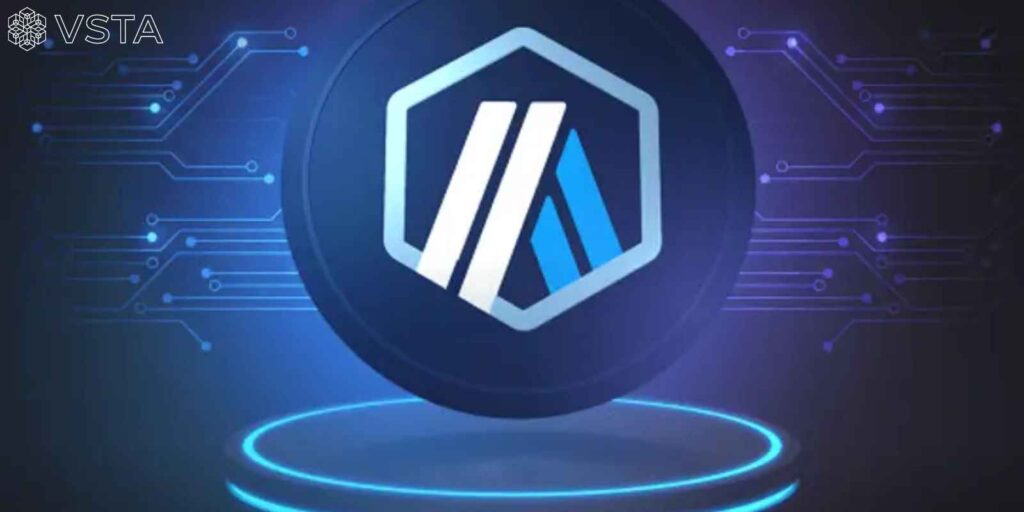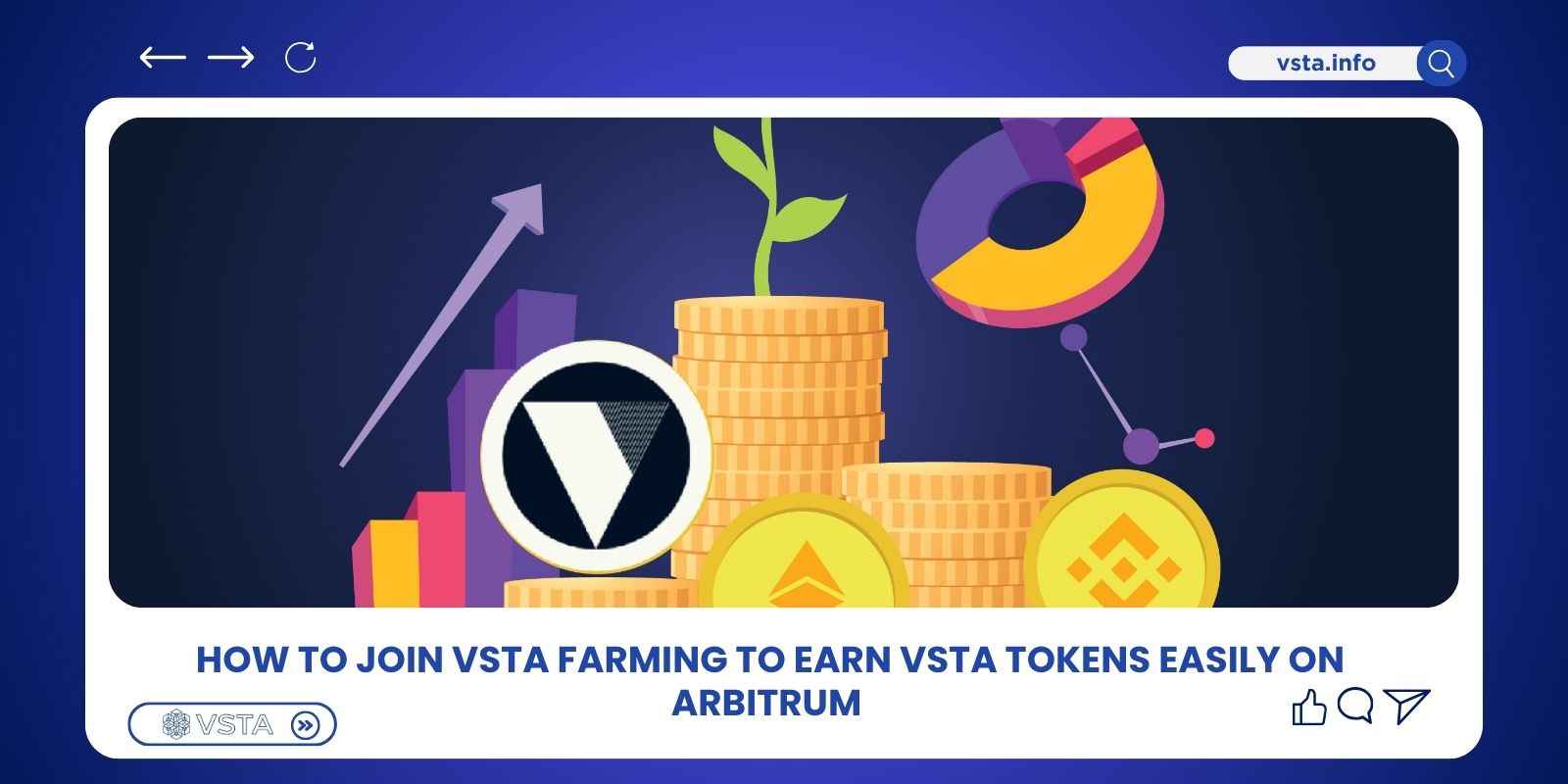In the 2025 DeFi wave, VSTA farming is becoming a hot keyword as it offers the potential for dual returns. Users both provide liquidity and hold the high-potential VSTA governance token. But is its mechanism really as simple and safe as the buzz suggests? Follow the article below from VSTA.Info for more details!
What is VSTA Farming?
Farming (or yield farming) is the practice of locking crypto assets into liquidity pools or smart contracts to earn rewards typically the protocol’s tokens. In the case of Vesta Finance, “VSTA farming” refers to providing liquidity (liquidity mining) or staking to earn rewards in VSTA tokens.
What makes VSTA farming stand out is that:
- The protocol runs on Arbitrum, offering low fees and high speed.
- Competitive APY rewards attract many DeFi users seeking stable yield.
- VSTA is both a utility and governance token; beyond trading, it directly influences the future direction of Vesta Finance.
How VSTA Farming Works
Participation Requirements
To start VSTA farming, users need to access Vesta Finance and collateralize supported crypto assets such as ETH, gOHM, GMX, DPX, or rETH. Upon collateralization, the system allows users to mint the stablecoin VST (Vesta Stable Token) a decentralized stablecoin backed by their own collateralized assets.
The minimum collateral ratio typically ranges between 110% and 150%, depending on the asset type. If the asset price drops and the ratio falls below the required threshold, the borrowing position will be automatically liquidated to maintain the protocol’s stability.
Joining Liquidity Mining Pools
After successfully minting VST, users can provide liquidity to pools such as VSTA-ETH, VST-FRAX, or VST-USDC on decentralized exchanges like Curve, Balancer, or Uniswap (Arbitrum).
Providing liquidity increases the overall liquidity of the Vesta Finance ecosystem while unlocking the opportunity to earn farming rewards. Users receive LP tokens (Liquidity Provider tokens) after depositing into the pool, which can then be staked on the Vesta Finance platform to earn VSTA token rewards.

Earning VSTA Tokens Through Farming
Each liquidity pool is allocated a certain amount of VSTA token rewards over time. The longer users stake their LP tokens, the greater their rewards, and they can claim their VSTA tokens at any time.
Rewards are calculated based on:
- The user’s share of total liquidity (LP share)
- The duration of LP token staking
The APY for each pool typically ranges from 15% to 80%, depending on the distribution phase. Additionally, VSTA holders can stake their VSTA tokens to earn extra rewards or participate in governance, voting to adjust reward allocations across different pools.
Collateral Ratios, Liquidation, Gas Fees, and Layer 2 Efficiency
While VSTA farming offers attractive yields, participants should understand the technical risks involved:
- Liquidation risk: If the price of collateralized assets drops sharply, the position may be automatically liquidated to maintain system stability.
- Price volatility risk: The prices of VSTA and VST tokens can fluctuate, directly affecting farming returns.
- Gas fees: Although Arbitrum significantly reduces transaction costs, users still need a small amount of ETH to pay gas fees for minting, staking, or claiming rewards.
- Smart contract risk: Like all DeFi projects, Vesta Finance relies on smart contracts. Despite audits, technical vulnerabilities may still exist.
By leveraging Arbitrum’s Layer 2 infrastructure, Vesta Finance optimizes transaction speed and minimizes costs making. VSTA farming a popular choice for DeFi investors looking to maximize returns on a platform that is safer and more efficient than the Ethereum mainnet.
Advantages and Disadvantages of VSTA Farming
Advantages of VSTA Farming
VSTA Farming offers several significant advantages for users participating in the Vesta Finance ecosystem, especially in the increasingly competitive DeFi landscape:
- Users can accumulate VSTA tokens by participating in farming rather than purchasing them on exchanges. This approach reduces initial investment costs and increases flexibility in asset accumulation strategies.
- Instead of letting crypto assets sit idle in wallets, users can collateralize them to borrow the stablecoin VST and then use that VST to participate in farming. This approach maximizes capital efficiency, allowing one asset to serve both as collateral and a source of passive income.
- Since Vesta Finance operates on Arbitrum, it significantly reduces gas fees compared to the Ethereum mainnet. Users also enjoy a smoother experience when staking, farming, or claiming rewards.
- The Vesta Finance protocol has undergone independent audits, enhancing safety and building user confidence in participating in farming activities.

Disadvantages of VSTA Farming
Although VSTA farming offers attractive returns, it also carries several risks that users should carefully consider:
- When the price of ETH or other collateral assets drops sharply, the collateral ratio can fall below the safety threshold, triggering automatic liquidation to protect the protocol.
- Although Arbitrum offers lower fees than Ethereum mainnet, users still need to pay ETH gas fees for actions such as minting, depositing, staking, or withdrawing especially when the network is congested.
- If the price of VSTA decreases during the farming period, the actual return (APR/ROI) may drop significantly. Likewise, if the VST stablecoin loses its peg (though rare), it could also reduce farming efficiency.
- For beginners, understanding the entire process – collateralization, minting, staking, and claiming can be challenging, potentially leading to operational mistakes or misjudging associated risks.
How to Participate in VSTA Farming
To start VSTA Farming and earn VSTA token rewards, users need to follow a few basic steps:
Prepare Your Wallet and Arbitrum Network
- Create or use a MetaMask wallet (or any EVM-compatible wallet such as Rabby or Coinbase Wallet).
- Connect your wallet to the Arbitrum network:
Open MetaMask → Select Add Network.
Enter the Arbitrum One network details.
Save to complete the connection.
- Deposit ETH into your Arbitrum wallet to pay for gas fees and use as collateral (if needed).

Collateralize Assets to Mint the VST Stablecoin
Step 1: Access the Vesta Finance App.
Step 2: Choose the asset you want to collateralize (e.g., ETH, gOHM, GMX, DPX).
Step 3: Enter the amount of the asset you wish to deposit and mint VST (Vesta Stable Token).
Step 4: Confirm the transaction in your wallet.
Step 5: Once complete, your VST balance will appear in your wallet — this is the stablecoin you can use for farming.
Join a Liquidity Pool (Liquidity Mining)
Step 1: Go to the “Farming” or “Liquidity Pools” section on Vesta Finance or supported DEXs such as Curve, Uniswap, or Balancer (Arbitrum).
Step 2: Choose the pool you want to participate in, for example:
- VSTA-ETH pool – the most popular with higher returns.
- VST-FRAX pool – more stable with lower risk.
Step 3: Provide liquidity by depositing the corresponding token pair (e.g., VSTA and ETH in a 50/50 ratio).
Step 4: Receive LP tokens (Liquidity Provider Tokens) after successfully adding liquidity.
Stake LP Tokens to Earn VSTA Rewards
Step 1: Return to the Vesta Finance – Staking/Farming Dashboard.
Step 2: Select the corresponding pool and stake your LP tokens.
Step 3: Once staked, the system will start calculating your rewards in real time.
Step 4: You can claim your VSTA token rewards at any time, or let them accumulate to optimize gas fees.
Monitor, Withdraw, and Reinvest
When you decide to stop farming, you can:
- Unstake LP tokens.
- Withdraw liquidity from the pool to receive your original assets.
- Repay borrowed VST (if any) to unlock your collateralized assets.
Conclusion
VSTA Farming is one of the standout opportunities in the DeFi ecosystem on Arbitrum, offering a new way to leverage crypto assets to generate passive income.
Through its collateralization – stablecoin borrowing – liquidity providing – reward earning mechanism, Vesta Finance has built a transparent, efficient, and user-friendly yield farming model. It is hoped that the information above will help users better understand how to engage in VSTA Farming effectively.
